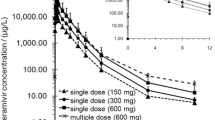Abstract
The pharmacokinetics and bioavailability of (±)-carbovir, a carbocyclic nucleoside active against human immunodeficiency virus, have been described previously. To determine the bioavailability of (–)-carbovir, the biologically active enantiomer, four male Sprague–Dawley rats received 18 mg/kg of (–)-carbovir through the jugular vein and 54 mg/kg orally. Following the pilot studies, five rats were randomly assigned to receive (–)-carbovir in a three-way crossover design as either a single 18-mg/kg iv bolus, a single 54-mg/kg oral dose, or a single iv infusion of 18 mg/kg to achieve a target steady-state concentration (C ss) of 1 µg/ml, the peak concentration after an oral dose. Blood and urine samples were analyzed by an improved ion-paired reversed-phase HPLC method with fluorescence detection. Blood concentrations of (–)-carbovir declined in a biphasic manner after the iv bolus dose. The terminal half-life was 116 and 106 min after the iv bolus and oral dose, respectively. The blood/plasma distribution ratio was approximately 1.0 in the range of 1 to 10 µg/ml of (–)-carbovir in blood. The free fraction in serum was concentration dependent. Significant differences in the renal, nonrenal, and total-body clearances after the iv bolus and iv infusion suggested nonlinear elimination of (–)-carbovir. The oral bioavailabilities derived from blood data were significantly different when the iv bolus was used as a reference rather than the iv infusion. However, the bioavailabilities were not significantly different when the total urinary excretion of unchanged (–)-carbovir after iv bolus or infusion was used as a reference. Concomitant saturation of renal and nonrenal clearances might explain these findings. The oral bioavailability was about 20% at concentrations approximating 1 µg/ml in blood.
Similar content being viewed by others
REFEREMCES
R. Vince, M. Hua, J. Brownell, S. Daluge, F. Lee, W. M. Shannon, G. C. Lavelle, J. Qualls, O. S. Weislow, R. Kiser, P. G. Canonico, R. H. Schultz, V. L. Narayanan, J. G. Mayo, R. H. Shoemaker, and M. R. Boyd. Potent and selective activity of a new carbocyclic nucleoside analog (carbovir: NSC 614846) against human immunodeficiency virus in vitro. Biochem. Biophys. Res. Comm. 156:1046–1053 (1988).
E. L. White, W. B. Parker, L. J. Macy, S. C. Shaddix, G. McCaleb, J. A. Secrist III, R. Vince, and W. M. Shannon. Comparison of the effect of carbovir, AZT and dideoxynucleoside triphosphates on the activity of human immunodeficiency virus reverse transcriptase and selected human polymerases. Biochem. Biophys. Res. Comm. 161:393–398 (1989).
Y.-H. Yeom, R. P. Remmel, S.-H. Huang, M. Hua, R. Vince, and C. L. Zimmerman. Pharmacokinetics and bioavailability of carbovir, a carbocyclic nucleoside active against human immunodeficiency virus, in rats. Antimicrob. Agents Chemother. 33:171–175 (1989).
R. Vince and J. Brownell. Resolution of racemic carbovir and selective inhibition of human immunodeficiency virus by the (−)-enantiomer. Biochem. Biophys. Res. Comm. 168:912–916 (1990).
R. Vince and M. Hua. Synthesis and anti-HIV activity of carbocyclic 2′,3′-didehydro-2′,3′-dideoxy-2,6-disubstituted purine nucleosides. J. Med. Chem. 33:17–21 (1990).
R. P. Remmel, S.-H. Huang, D. Hoff, and C. L. Zimmerman. Improved fluorometric HPLC assay for (−)-carbovir in rat blood and urine. J. Chromatogr. 534:109–118 (1990).
S. P. Assenza and P. R. Brown. Ultraviolet and fluorescence characterization of purines and pyrmidines by post-column pH manipulation. J. Chromatogr. 289:355–365 (1984).
U. W. Wiegand, J. T. Slattery, K. L. Hintze, and G. Levy. Differences in the protein binding of several drugs and bilirubin in serum and heparinized plasma of rats. Life Sci. 25:471–478 (1979).
M. Gibaldi and D. Perrier. Pharmacokinetics, 2nd ed., Marcel Dekker, New York, 1982.
StatView512 +, BrainPower Inc., 1986.
K. R. Brouwer, R. L. St. Claire, and J. Lagarde. The pharmacokinetics of (−)-carbovir in rats following IV infusion: Evidence for non-linear elimination. Pharm. Res. 6:S187 (1989).
W. S. Spector. Handbook of Biological Data, W.B. Saunders, Philadelphia, 1956.
G. J. Mulder, S. Brouwer, J. G. Weitering, E. Scholtens, and K. S. Pang. Glucuronidation and sulfation in the rat in vivo: The role of the liver and intestine in the in vivo clearance of 4-methylumbelliferone. Biochem. Pharmacol. 34:1325–1329 (1985).
Author information
Authors and Affiliations
Rights and permissions
About this article
Cite this article
Huang, Sh., Remmel, R.P. & Zimmerman, C.L. The Bioavailability and Nonlinear Clearance of (–)-Carbovir in the Rat. Pharm Res 8, 739–743 (1991). https://doi.org/10.1023/A:1015850017201
Issue Date:
DOI: https://doi.org/10.1023/A:1015850017201




